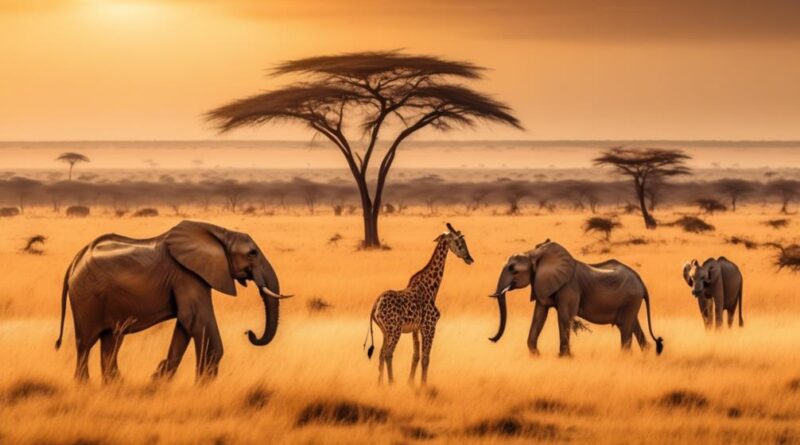Top African Wildlife Photography Locations: 11 Expert Tips
If you've ever dreamed of capturing stunning wildlife photographs, Africa is a continent that offers an unparalleled opportunity to do so.
In fact, did you know that Africa is home to over 1100 different species of mammals and 2600 species of birds?
When it comes to wildlife photography, the diverse landscapes and rich biodiversity of Africa make it a top choice for photographers seeking to capture the raw beauty of nature.
But with so many incredible locations to choose from, how do you know where to begin your photographic journey?
Serengeti National Park
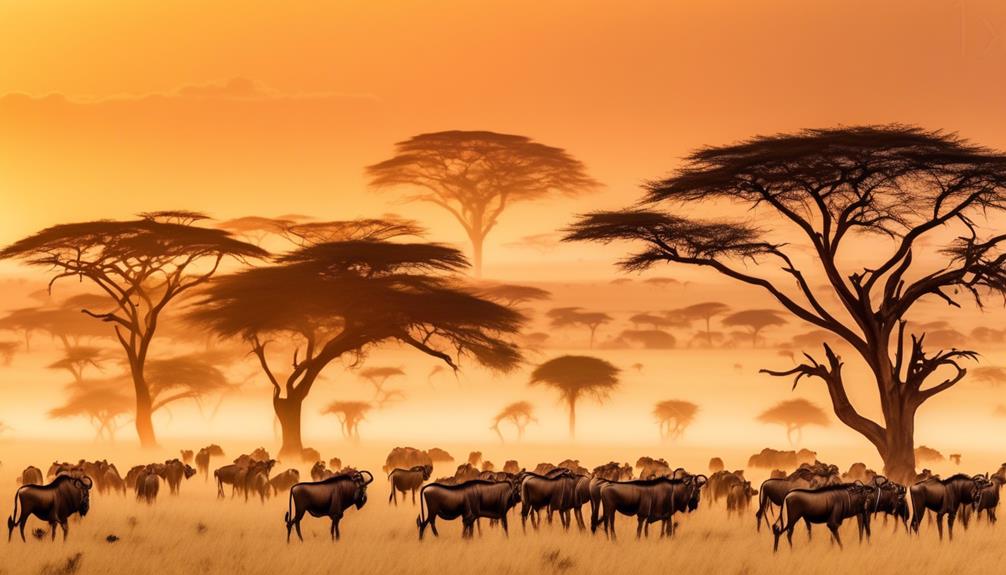
When visiting Serengeti National Park, you'll encounter an extraordinary array of wildlife in their natural habitat. The park is renowned for the annual Serengeti migration, where millions of wildebeest and zebra traverse the plains in search of fresh grazing grounds. This phenomenon provides a spectacular opportunity for wildlife photography, allowing you to capture the raw power and beauty of this natural spectacle.
To make the most of your wildlife photography experience in Serengeti National Park, consider employing some key techniques. Firstly, understanding animal behavior is crucial. Patience is essential, as observing the animals' habits and movements will enable you to anticipate and capture compelling shots.
Additionally, utilizing natural light to your advantage can significantly enhance your photographs. The soft, warm glow during the golden hours of sunrise and sunset can add a stunning dimension to your wildlife images.
Furthermore, employing the rule of thirds can help create visually engaging compositions. By placing the subject off-center, you can add depth and interest to your photos.
Lastly, consider using a telephoto lens to capture intimate close-ups without disturbing the animals. By following these wildlife photography techniques, you can elevate your experience in Serengeti National Park and capture breathtaking images of the diverse wildlife that call this region home.
Maasai Mara National Reserve
As you venture from the captivating wildlife of Serengeti National Park, the Maasai Mara National Reserve awaits with its own breathtaking array of animals and landscapes to capture through your lens. One of the most extraordinary events to witness and photograph in Maasai Mara is the annual Maasai Mara migration, where millions of wildebeest, zebras, and other herbivores cross the Mara River in search of greener pastures. To capture this awe-inspiring spectacle, consider using a telephoto lens to zoom in on the action while still maintaining a safe distance from the wildlife.
When photographing the wildlife in Maasai Mara, it's essential to employ some wildlife photography techniques to ensure stunning and compelling shots. Patience is key – spending time observing the animals' behavior will allow you to anticipate and capture those special moments. Additionally, understanding the play of light and shadow is crucial for creating dramatic and impactful images. Whether it's the golden light of sunrise or the warm hues of sunset, Maasai Mara's diverse landscapes provide ample opportunities for experimenting with different lighting conditions.
To truly capture the essence of Maasai Mara, don't limit yourself to wildlife close-ups. The reserve's expansive grasslands and acacia-dotted plains offer incredible panoramic vistas that can be just as captivating as the up-close animal shots. Consider bringing a wide-angle lens to capture the sweeping beauty of the savannah and showcase the animals within their majestic natural habitat.
Okavango Delta
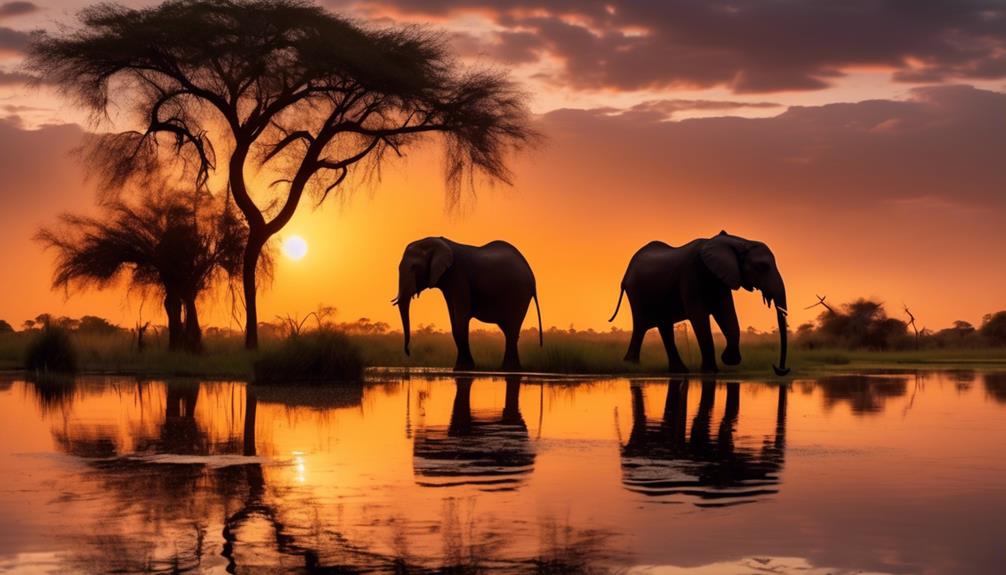
Nestled in the heart of Botswana, the Okavango Delta beckons with its labyrinth of waterways and lush islands, offering a paradise for wildlife enthusiasts and photographers alike. The delta is a haven for birdwatching, boasting over 400 species of birds, including the vibrant malachite kingfisher, majestic African fish eagle, and elusive Pel's fishing owl.
As you explore the water channels and floodplains, keep your camera ready to capture these magnificent avian creatures in their natural habitat.
One of the best ways to experience the Okavango Delta is through Mokoro safaris. Glide silently through the tranquil waters in a traditional dugout canoe, allowing for intimate encounters with wildlife and unhindered photography opportunities. Your expert local guides will navigate through the maze of reeds and papyrus, offering insights into the diverse ecosystem and helping you spot extraordinary birdlife along the way.
Whether you're capturing the grace of a heron taking flight or the comical antics of a malachite kingfisher diving for its next meal, the Okavango Delta presents unparalleled opportunities for wildlife photography. As the sunlight dances on the water and the reeds sway gently in the breeze, you'll find yourself immersed in a picturesque setting, surrounded by the symphony of bird calls and the wonders of nature.
Embrace the serenity of this unique wetland oasis and let your camera tell the story of the Okavango Delta's avian wonders.
Kruger National Park
Located in northeastern South Africa, Kruger National Park offers an unparalleled opportunity for wildlife enthusiasts and photographers to immerse themselves in the natural beauty of the African savanna. The park's vast expanse and diverse ecosystems make it a prime location for capturing stunning wildlife photography.
Here are some tips to make the most of your photographic experience at Kruger National Park:
- Best Photography Spots: The park is teeming with wildlife, and certain areas offer better opportunities for photography. The S65 road near the Mopane Camp is known for its leopard sightings, while the Timbavati River and Red Rocks are great for photographing elephants and buffalo. The N'wanetsi Picnic Spot provides a stunning backdrop for bird photography, especially during sunrise and sunset.
- Wildlife Photography Tips: To capture the best shots, consider hiring a professional guide who's familiar with the park and its wildlife. Patience is key in wildlife photography, so spend time observing animal behavior to anticipate moments worth capturing. Early mornings and late afternoons offer the best lighting conditions for photography, and using a telephoto lens can help you get close-up shots without disturbing the animals.
- Preparation: Ensure your camera gear is ready for the rugged terrain and dusty conditions of the park. It's also essential to pack sufficient water, snacks, and protective clothing for long hours in the field. Additionally, familiarize yourself with the park's rules and regulations regarding photography to ensure a respectful and responsible experience.
Kruger National Park presents an incredible opportunity to capture the raw beauty of African wildlife through photography. By following these tips, you can enhance your experience and come away with breathtaking images of the diverse fauna that call this iconic park home.
Chobe National Park
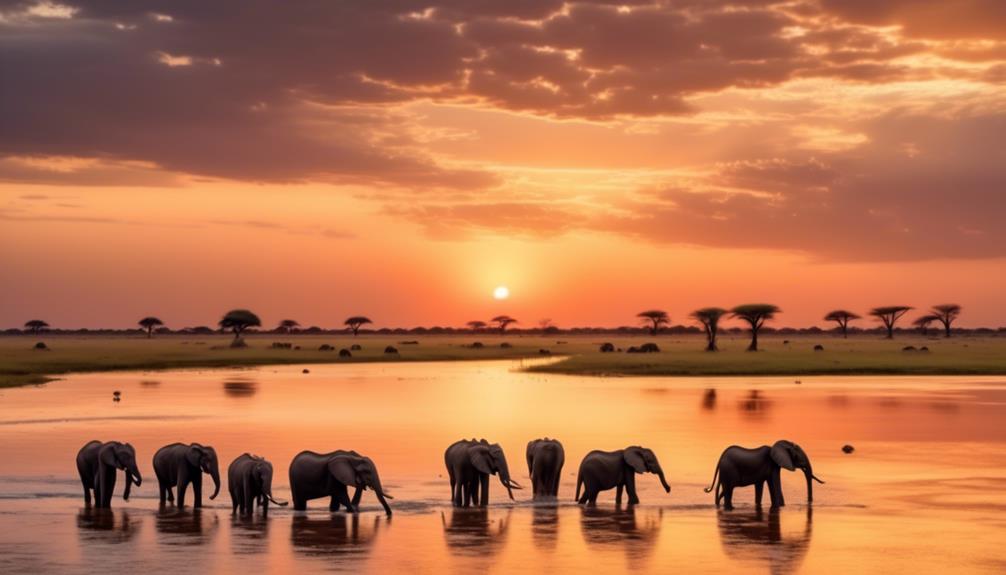
Kruger National Park offers an unparalleled opportunity for wildlife enthusiasts and photographers to immerse themselves in the natural beauty of the African savanna. When exploring Chobe National Park, you'll discover a diverse landscape teeming with unique photography opportunities.
Chobe National Park, located in Botswana, is renowned for its stunning river safaris along the Chobe River. The river safari provides an exceptional chance to capture incredible images of elephants, hippos, crocodiles, and a variety of bird species as they gather around the water's edge. The golden light of sunrise or sunset offers the perfect backdrop for photographing these majestic animals in their natural habitat.
In addition to the river safari, Chobe National Park is a paradise for bird watching enthusiasts. The park is home to over 450 bird species, making it a haven for bird photography. From the vibrant carmine bee-eaters to the iconic African fish eagle, you'll have the opportunity to capture the beauty and diversity of African birdlife. The varied habitats within the park, including floodplains, woodlands, and savannas, offer a rich tapestry of backdrops for your bird photography adventures.
As you venture through Chobe National Park, be prepared to encounter breathtaking scenes and unique wildlife encounters at every turn. Whether you're on a river safari or scanning the skies for a glimpse of a rare bird species, Chobe National Park presents endless opportunities for capturing stunning wildlife photographs.
Etosha National Park
Etosha National Park in Namibia presents a captivating landscape where wildlife enthusiasts and photographers can witness the unfolding drama of the African savanna. The park's unique features and abundant wildlife make it an ideal destination for unforgettable wildlife photography and safari experiences.
- Waterhole Photography: Etosha is renowned for its numerous natural and man-made waterholes, providing exceptional opportunities to capture stunning images of wildlife congregating to drink, bathe, and interact. These waterholes offer a front-row seat to observe and photograph a diverse array of animals, including elephants, giraffes, zebras, and various antelope species.
- Salt Pan Vistas: The vast Etosha salt pan, visible from space, creates a striking backdrop for wildlife photography. The stark, white expanse contrasts with the silhouettes of animals, particularly during sunrise and sunset, making for dramatic and visually captivating images.
- Night Photography: Etosha National Park offers fantastic opportunities for night photography, allowing visitors to capture mesmerizing images of nocturnal wildlife, such as lions, hyenas, and elusive leopards. The park's designated floodlit waterholes provide a unique setting for capturing compelling nighttime scenes of wildlife activity.
The park's accessibility and well-maintained road network make it convenient for self-drive safaris, while guided game drives and walking safaris offer alternative ways to explore and photograph the abundant wildlife. Whether you're an amateur photographer or a seasoned professional, Etosha National Park promises an enriching and rewarding wildlife photography experience amidst the untamed beauty of the African wilderness.
Moremi Game Reserve
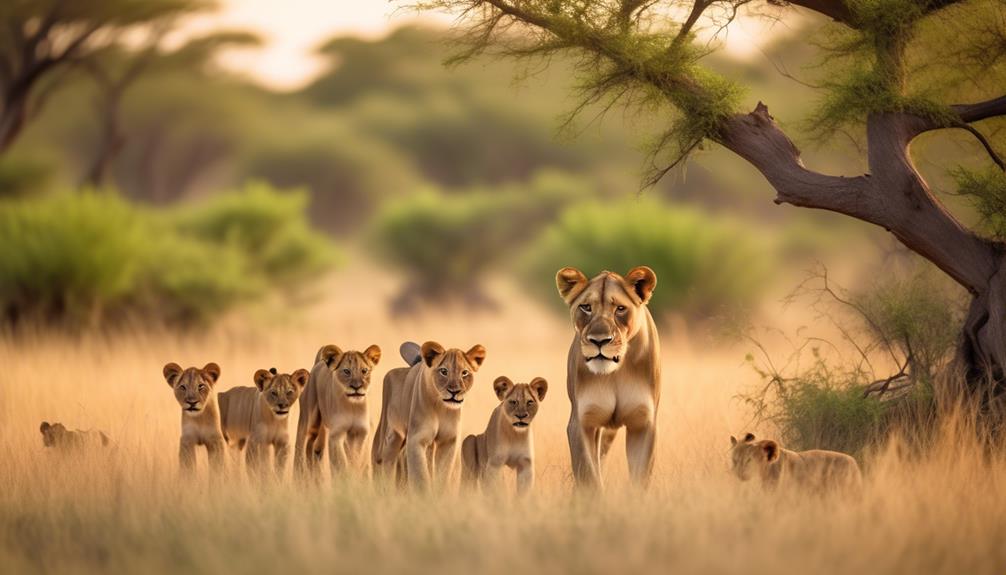
As you explore the diverse opportunities for wildlife photography in Africa, Moremi Game Reserve in Botswana emerges as an equally captivating destination, offering a rich and varied landscape to capture the essence of the African wilderness. The reserve is renowned for its exceptional wildlife diversity, providing photographers with the chance to capture a wide range of species in their natural habitat. From majestic elephants and graceful giraffes to elusive leopards and powerful lions, Moremi Game Reserve presents an incredible array of photographic opportunities.
When preparing your photography equipment for Moremi Game Reserve, it's essential to pack versatile gear that can accommodate a variety of shooting conditions. A quality telephoto lens is indispensable for capturing detailed close-ups of wildlife from a distance, while a wide-angle lens can help you showcase the expansive landscapes and breathtaking vistas that the reserve has to offer. Additionally, a sturdy tripod can be beneficial for achieving stability and precision in your shots, especially during low-light conditions or when photographing stationary subjects.
As you venture into Moremi Game Reserve, remember to exercise caution and respect for the wildlife and environment. Keep a safe distance from the animals and refrain from disrupting their natural behaviors for the sake of a photograph. By prioritizing the well-being of the wildlife and embracing the raw beauty of the African wilderness, you can create stunning and ethically responsible wildlife photography in Moremi Game Reserve.
Ngorongoro Conservation Area
Nestled in northern Tanzania, the Ngorongoro Conservation Area offers a captivating blend of wildlife and breathtaking landscapes for photographers to capture. This UNESCO World Heritage site is home to a vast array of wildlife and is renowned for its high density of predators, making it a prime location for wildlife photography opportunities.
Here are a few things to keep in mind when planning your photography adventure in the Ngorongoro Conservation Area:
- Wildlife Photography Opportunities: The Ngorongoro Crater, the centerpiece of the conservation area, provides a natural enclosure for a wide variety of wildlife, including lions, elephants, buffalo, and rhinos. The crater's unique topography and the abundance of wildlife make it an ideal setting for capturing stunning wildlife photographs. Be prepared to adjust your camera settings quickly to adapt to changing lighting conditions and fast-moving subjects.
- Conservation Efforts and Impact: The Ngorongoro Conservation Area isn't only a hotspot for wildlife photography but also a critical area for conservation efforts. The Maasai people coexist with the wildlife in this area, and their sustainable land use practices play a vital role in the conservation of the region's natural resources. When visiting the Ngorongoro Conservation Area, it's important to respect the local customs and support the conservation efforts that help protect the area's biodiversity.
- Tips for Capturing the Landscape: In addition to wildlife photography, the Ngorongoro Conservation Area offers breathtaking landscapes, including the vast grasslands and the Lerai Forest. To capture the stunning beauty of the area, consider using wide-angle lenses and experimenting with different perspectives to showcase the scale and grandeur of the landscapes. Be mindful of the changing light throughout the day and utilize the golden hours for the best lighting conditions.
Frequently Asked Questions
What Are the Best Times of Day for Wildlife Photography in These Locations?
For the best wildlife photography, aim for the golden hour when the lighting is perfect and wildlife behavior is active. This time of day provides the best lighting and captures animal activity at its peak.
Are There Any Specific Photography Regulations or Guidelines That Visitors Should Be Aware Of?
When visiting these locations, be aware of photography regulations and visitor guidelines to minimize impact and preserve the environment. Follow rules regarding distance from wildlife, use of flashes, and any specific guidelines set by park authorities.
What Are Some Lesser-Known Species or Unique Wildlife Photography Opportunities in These Areas?
For some lesser-known species and unique wildlife photography opportunities in these areas, explore hidden gems and remote opportunities. Keep an eye out for rare sightings that make for stunning and exclusive photography experiences.
How Can Photographers Minimize Their Impact on the Environment and Wildlife While Taking Pictures?
To minimize impact on the environment and wildlife while taking pictures, use conservation techniques like staying on designated paths, keeping a safe distance from animals, and avoiding disruptive behavior. Respect nature and capture stunning shots responsibly.
Are There Any Special Photography Tours or Workshops Available in These Locations?
There are photography tours and workshops available in these locations. They provide expertise on photography equipment and editing techniques. These experiences will enhance your skills and offer unique opportunities for capturing stunning wildlife shots.
Conclusion
So pack your camera and head to one of these top African wildlife photography locations.
With expert tips in mind, you'll be sure to capture stunning images of the diverse and magnificent wildlife that call these places home.
Don't forget to respect the animals and their natural habitat while you're there, and always prioritize their well-being over getting the perfect shot.
Happy shooting!
